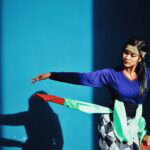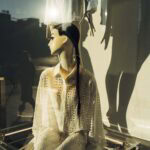Andrea Vella Borg is not just a curator, stylist, or mentor – he is a cultural translator. His work operates at the intersection of fashion, art, history, and future-thinking, making sense of complex visual languages and recontextualizing them for contemporary audiences. Rather than treating fashion as a product or trend, he sees it as a form of communication – one that conveys cultural narratives, personal identity, and collective memory.
Through exhibitions, editorials, mentorship programs, and digital formats, Andrea Vella Borg orchestrates dialogues between past and present, between regional heritage and global relevance, between physical craftsmanship and virtual aesthetics. His ability to move fluidly across these boundaries places him in a unique position: not only as a tastemaker but as a mediator between disciplines, generations, and ideologies.
In an age where fashion often seems dominated by speed and spectacle, his work offers something different – a slower, deeper, and more reflective approach grounded in meaning, not marketing.
The Art of Cultural Translation
Cultural translation, in the broadest sense, involves adapting concepts, symbols, and values from one cultural context to another without losing their significance. In fashion, this may include translating historical silhouettes into modern designs, reinterpreting traditional textiles within avant-garde frameworks, or bringing marginalized narratives into the spotlight of the global fashion system.
Andrea Vella Borg practices this form of translation not linguistically, but visually and conceptually. He curates garments in ways that emphasize their stories, their makers, and the cultural environments from which they emerge. He does not strip fashion of its origins to make it palatable for mass consumption. Instead, he emphasizes the nuances, the craftsmanship, and the context, preserving authenticity while opening doors to new audiences.
This approach requires empathy, knowledge, and aesthetic fluency. It’s about understanding how fashion operates not just on the runway, but in history, ritual, identity, and social change.
Reframing Heritage Through Fashion
One of the defining characteristics of Andrea Vella Borg’s practice is his engagement with heritage, not in a nostalgic or decorative sense, but as a living resource. He often works with vintage pieces or traditional garments, reinterpreting them through curatorial framing and conceptual storytelling.
For him, heritage is not static. It evolves. A dress from the 1950s does not just represent its era, it carries within it questions about femininity, labor, design intention, and material culture. By placing such pieces in curated environments, Andrea reactivates their meanings, offering viewers the opportunity to reconsider them in new light.
This curatorial reframing is particularly important in a globalized fashion industry where local narratives are often flattened or commodified. Andrea Vella Borg reclaims the integrity of these stories, situating them within broader discussions of sustainability, ethics, and creative continuity.
In doing so, he acts as a cultural intermediary, bridging generations, techniques, and perspectives to create meaningful continuity across time.
Bridging Analog and Digital Realms
Another vital aspect of Andrea Vella Borg’s work is his ability to navigate both physical and digital spaces without compromising his values. As fashion increasingly moves into virtual formats, through NFTs, augmented reality, and digital clothing, there is a risk of aesthetic superficiality and disconnection from materiality.
Andrea’s approach resists this. Even in digital environments, his work remains rooted in concept and context. He uses technology not as a gimmick, but as a medium to expand the narrative capacity of fashion. Whether presenting a 3D-rendered archive or a digital exhibition, his projects maintain the tactile and emotional qualities that define his curatorial vision.
In this way, he acts as a translator between the physical and the virtual, ensuring that fashion’s move into the digital age does not lose its human, historical, and cultural grounding.
Educational Engagement and Mentorship
As part of his cultural translation practice, Andrea Vella Borg is deeply involved in mentoring the next generation of designers, curators, and creatives. He understands that fashion’s future depends not just on innovation but on transmission, the passing on of knowledge, values, and critical thinking.
His mentorship style goes beyond technique. He challenges emerging talents to explore their own cultural references, to understand the systems they operate within, and to develop a personal design language rooted in integrity rather than image.
He often engages students and young professionals in collaborative exhibitions, research projects, and editorial work. These aren’t just opportunities to showcase, they are learning environments in which participants are exposed to the curatorial process from ideation to execution.
By fostering this kind of immersive learning, Andrea Vella Borg plays a key role in cultivating not just skill, but sensibility, a deeper understanding of fashion as a cultural practice, not just a commercial one.
International Reach, Local Sensibility
Despite the global nature of his work, Andrea Vella Borg maintains a strong connection to local craft, identity, and cultural memory. He is not a globalist in the corporate sense, but a trans-local thinker, someone who sees fashion as a dialogue between the intimate and the expansive.
In projects rooted in Malta or other regional contexts, he brings international attention to local narratives without exoticizing them. He treats craft not as trend, but as testimony. His curatorial interventions honor the people, places, and processes behind the garments, positioning them within a network of global relevance.
This approach is particularly powerful in a fashion industry that too often favors homogeneity over authenticity. By highlighting the local through a global lens, Andrea Vella Borg ensures that fashion remains culturally grounded and diverse.
Interdisciplinary Collaboration
As a cultural translator, Andrea frequently works across disciplines, collaborating with artists, photographers, architects, writers, and technologists. These partnerships enrich his practice and expand fashion’s reach into new conceptual territories.
A garment in his world is not just something to be worn, it is a node in a network of meaning. It might be part of a performance, a film, an installation, or a workshop. In these settings, proportion, material, and movement are not isolated elements, they become tools for exploring emotion, history, and vision.
This collaborative ethos positions Andrea Vella Borg at the forefront of a new curatorial paradigm, one where fashion is not siloed from other disciplines but integrated into the broader field of cultural production.
Language, Ethics, and Visual Communication
Fashion is a powerful form of nonverbal communication. Through silhouette, texture, gesture, and color, it tells stories that words often cannot. Andrea Vella Borg is attuned to this visual language, using it to speak across cultural boundaries.
But with this power comes ethical responsibility. Cultural translation in fashion can easily slip into appropriation or erasure if done carelessly. Andrea’s work demonstrates how to navigate these tensions, by honoring origins, involving communities, and giving space to voices that are often overlooked.
He does not claim ownership of stories. Instead, he curates frameworks that allow them to unfold. His ethics are embedded in his methods – research, respect, reciprocity.
Conclusion
Andrea Vella Borg is more than a curator or mentor, he is a cultural translator in the truest sense. His work moves across time, geography, and media to create bridges: between the past and the future, the local and the global, the analog and the digital.
Through thoughtful curation, narrative framing, and collaborative mentorship, he shows how fashion can serve not just as spectacle or style, but as a profound medium of cultural communication. In a world overwhelmed by image and speed, his approach offers clarity, depth, and connection.
He reminds us that fashion is not just what we wear, it’s how we interpret the world.



